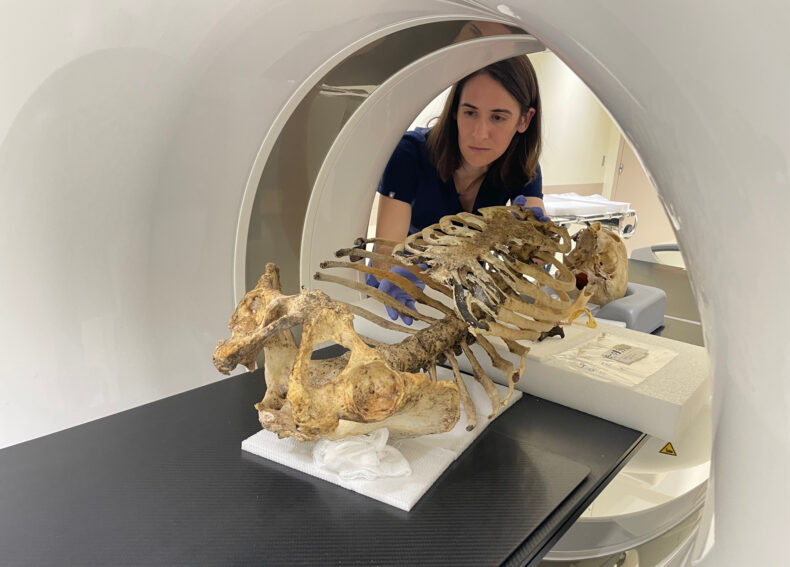Dutch computer scientists and colleagues in the United States have achieved a marked improvement in the automatic detection of calcified atherosclerotic plaque in coronary arteries and thoracic aorta using computerized tomography (CT).
Reporting this Feb. 11 in the journal Radiology, they demonstrated that a deep-learning algorithm for artificial intelligence-assisted calcium scoring they developed can accurately determine cardiovascular risk across a range of CT scans and in a racially diverse population.
Deep-learning algorithms are a form of artificial intelligence that enable computers to “learn” from examples to perform a task. This one was developed and evaluated with the help of co-author J. Jeffrey Carr, MD, MSCE, the Cornelius Vanderbilt Chair in Radiology & Radiological Sciences in the Vanderbilt University School of Medicine.

“Coronary calcium has been previously established as an excellent test for reclassifying an individual’s risk for heart disease as either high or low risk,” Carr said. “Developing a fully automated method that can perform the measurement of coronary calcium from CT scans accurately has a lot of value.
“I’m enthusiastic that versions of this could be implemented in (clinical) practice in a relatively few years and thus lower the barriers to identifying those people at high risk for heart disease,” he said.
The algorithm was trained and evaluated by the paper’s senior author, Ivana Išgum, PhD, a world leader in AI and medical imaging, her graduate student and first author, Sanne GM van Velzen, and colleagues at Amsterdam University Medical Center and University Medical Center Utrecht.
The work is based on a calcium scoring algorithm in the National Lung Screening Trial (NLST) that Išgum and graduate student Nikolas Lessmann developed in a collaboration between University Medical Center Utrecht and Radboud University Medical Center in Nijmegen.
The algorithm was built and evaluated using 7,240 CT scans, including nearly 2,900 from the Jackson Heart Study of African Americans in Jackson, Mississippi, 1,400 from patients treated for breast cancer in the Netherlands, and more than 1,000 from the NLST, which was conducted in 2002-2004.
Carr helped plan the study and gained access to the CT scans from the Jackson Heart Study, which is supported by the National Heart, Lung, and Blood Institute (NHLBI) of the National Institutes of Health (NIH), and from the NLST, which was supported by the National Cancer Institute.
“This study demonstrates the growing potential of artificial intelligence-assisted technology to enhance efforts to improve the detection of heart disease, the leading cause of death in this country,” said David Goff, MD, PhD, director of the Division of Cardiovascular Sciences at NHLBI.
“It is part of an ongoing effort by researchers supported by the NHLBI to develop AI tools that can rapidly sift through vast amounts of biomedical data to identify patterns that can help detect disease and hopefully save lives.”
“The American people and NIH have invested in these studies over decades to help us reduce the burden of heart and lung disease,” Carr added. “Thanks to carefully saving the original full fidelity images, we’re now able to use CT images and data volunteered by our participants in some cases more than a decade ago to build and train AI algorithms, techniques that did not exist when the studies began.”
Carr, who came to Vanderbilt in 2013, developed one of the first CT scanners to measure coronary calcium in 1998 while on the faculty of Wake Forest University School of Medicine in Winston-Salem, N.C.
Over the years, CT calcium “scoring” has become an important tool for understanding and determining heart disease risk.
“If you have no coronary calcium, your risk of having a heart attack in the next five years is less than 1%,” Carr said. “But if you have started to develop calcified plaque, even in your 40s and 50s, the risk can jump five- to twentyfold depending on the calcium score.
“We have not done as good a job at identifying and addressing risk factors in some populations in the United States,” he added. “Globally we need to lower barriers (to testing and treatment) to reduce the burden of heart disease worldwide.”
To broaden the application, Ivana Išgum and her colleagues, together with Carr’s input, trained an AI algorithm with CT scans with measurement of coronary calcium from the Jackson Heart Study cohort of African Americans and from the diverse participants in the NLST.
Goff noted that people should also recognize the need for other preventive efforts to fight heart disease, including physical activity, a healthy diet, regular sleep and avoidance of tobacco products.
Carr agreed. “The challenge is identifying people early in life when the prevention methods are likely to be the most effective,” he said. “By identifying individuals with relatively early coronary artery disease before they have any symptoms, we can support and encourage them to make the lifestyle changes and, if appropriate, offer them evidence-based interventions to address diabetes, elevated blood pressure, elevated cholesterol and smoking and effectively prevent or minimize the impact of heart disease.”
Supported by the Dutch Cancer Society, the research was conducted with the cooperation of Jackson Heart Study collaborators Jackson State University, Tougaloo College, the Mississippi State Department of Health and the University of Mississippi Medical Center in Jackson.

















